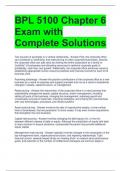BPL 5100 Chapter 6
Exam with
Complete Solutions
Two sources of synergies in a vertical relationship - Answer-First, the corporate office
can contribute to "parenting" and restructuring of (often acquired) businesses. Second,
the corporate office can add value by viewing the entire corporation as a family or
"portfolio" of businesses and allocating resources to optimize corporate goals of
profitability, cash flow, and growth. Additionally, the corporate office enhances value by
establishing appropriate human resource practices and financial controls for each of its
business units.
Parenting advantage - Answer-the positive contributions of the corporate office to a new
business as a result of expertise and support provided and not as a result of substantial
changes in assets, capital structure, or management
Restructuring - Answer-the intervention of the corporate office in a new business that
substantially changes the assets, capital structure, and/or management, including
selling off parts of the business, changing the management, reducing payroll and
unnecessary sources of expenses, changing strategies, and infusing the new business
with new technologies, processes, and reward systems
Asset restructuring - Answer-involves the sale of unproductive assets, or even whole
lines of businesses, that are peripheral. In some cases, it may even involve acquisitions
that strengthen the core business
Capital restructuring - Answer-involves changing the debt-equity mix, or the mix
between different classes of debt or equity. Although the substitution of equity with debt
is more common in buyout situations, occasionally the parent may provide additional
equity capital
Management restructuring - Answer-typically involves changes in the composition of the
top management team, organizational structure, and reporting relationships. Tight
financial control, rewards based strictly on meeting short- to medium-term performance
goals, and reduction in the number of middle-level managers are common steps in
, management restructuring. In some cases, parental intervention may even result in
changes in strategy as well as infusion of new technologies and processes
Portfolio management - Answer-a method of (a) assessing the competitive position of a
portfolio of businesses within a corporation, (b) suggesting strategic alternatives for
each business, and (c) identifying priorities for the allocation of resources across the
businesses
True or False? Research shows that a majority of acquisitions of public corporations
result in value destruction rather than value creation - Answer-True
Academic research has found that acquisitions, in general, do not lead to benefits for
share- holders - Answer-A review paper that looked at over 100 studies on mergers and
acquisitions concluded that research has found that acquisitions, on average, do not
create shareholder value
Divestiture - Answer-an admission that things didn't work out as planned
Diversification - Answer-the process of firms expanding their operations by entering new
businesses
Some types of diversification initiatives - Answer-mergers and acquisitions, strategic
alliances and joint ventures, or internal development
Synergy - Answer-derived from the Greek word synergos, which means "working
together"
Horizontal relationships - Answer-businesses sharing intangible resources (e.g., core
competencies such as marketing) and tangible resources (e.g., production facilities,
distribution channels)
Related linked - Answer-when the business units only share a few resources (e.g. Nike
shares the Nike brand and the swoosh logo across a number of its businesses but few
other resources)
Related constrained - Answer-when there are a large number of resource links between
the business units (e.g. Polaris uses shared components, designs, production facilities,
and distribution systems for its snowmobiles, ATVs, and electric vehicles)
Pro and Con of related constrained - Answer-The larger number of resource links in
related constrained diversification means there is greater potential value to extract from
the diversification, but it also means that the member businesses are constrained in the
actions they can take to win in each of their markets since any action one business unit
takes affects the other business units in the firm
Hierarchal relationships - Answer-value creation derived from the corporate office




